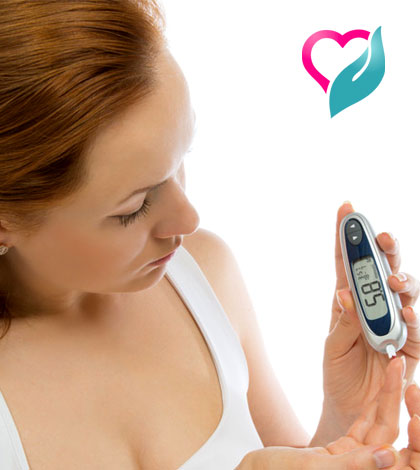Pre-diabetes is a condition in which blood glucose levels are higher than normal, but not high enough to be classified as full-blown diabetes. People with pre-diabetes are at increased risk of developing type-2 diabetes within a decade unless they adopt a healthier lifestyle that includes weight loss and more physical activity. They also have an increased risk of developing heart disease.
[wp_ad_camp_1]
Diabetes is defined as having a fasting plasma blood glucose level of 126 mg/dl or greater on two separate occasions. If diabetes symptoms exist and you have a casual blood glucose taken at any time that is equal to or greater than 200 mg/dl, and a second test shows the same high blood glucose level, then you have diabetes.
In general, people who have a fasting plasma blood glucose in the 100-125 mg/dl range are defined as having impaired fasting glucose. If your doctor gives you an oral glucose tolerance test, and at two-hours your blood glucose is 140-199 mg/dl, you have "impaired glucose tolerance". Be sure to ask your doctor what your exact blood sugar test results are when he tells you that you have "pre-diabetes." Some physicians are not as familiar as they should be with the new national guidelines for diagnosing diabetes. They may be telling you that you have pre-diabetes, when in fact you have actual diabetes.
[wp_ad_camp_4]
Pre-diabetes is when your fasting blood glucose (blood sugar) level is above normal.
Normal fasting glucose: 60 to 99 milligrams per deciliter (mg/dl)
Pre-diabetes (impaired fasting glucose): 100 to 125 mg/dl
Diabetes: 126 mg/dl or higher on 2 occasions
Among those who should be screened for pre-diabetes include overweight adults age 45 and older and those under age 45 who are overweight and who have one or more of the following risk factors:
- Are habitually physically inactive
- Have previously been identified as having IFG (impaired fasting glucose) or IGT (impaired glucose tolerance)
- Have a family history of diabetes
- Are members of certain ethnic groups (including Asian American, African-American, Hispanic American, and Native American)
- Have had gestational diabetes or have given birth to a child weighing more than 9 pounds
- Have elevated blood pressure
- Have an HDL cholesterol level (the “good” cholesterol) of 35 mg/dl or lower and/or triglyceride level of 250 mg/dl or higher
- Have polycystic ovary syndrome
- Have a history of vascular disease
[wp_ad_camp_2]
Subtle Symptoms of Diabetes
A few of these subtle symptoms should certainly prompt you to see your doctor. Consider asking yourself the following questions.
- Are you suddenly feeling much thirstier, hungrier, and losing weight without trying?
- Do you feel more fatigued or weaker than usual? If you've started exercising significantly more, these changes could be expected. But if your diet and exercise patterns have remained stable, discuss these changes with your doctor promptly.
- Are you experiencing blurred vision or recurring skin or gum infections?
- Have you noticed that cuts and bruises take longer to heal? Are you urinating more often or feeling tingling in your hands, feet, or legs?
These, too, may initially seem insignificant, especially in isolation. But having any combination of these symptoms should not be ignored.
Pre-Diabetes Management
Fortunately, if pre-diabetes is diagnosed early enough, the condition can be reversed through various lifestyle changes. Pre-diabetes should be taken as a warning sign. It presents you with an opportunity to make positive lifestyle changes to prevent pre-diabetes from developing into something much more serious. The key is to keep blood sugar levels within the target range. By doing this, the risk of further complications is significantly reduced.
What to Eat
If you are overweight, your first and foremost goal should be to lose weight. This means working with a registered dietitian to determine the quantity and type of food you should eat at each meal. One of the key issues in losing weight is controlling portion size. Your dietitian will also direct you how to make food choices that cut down on the amount of fat you eat because each gram of fat has significantly more calories in it than a gram of carbohydrate or protein.
Healthier choices of food are whole grains (whole wheat bread, brown rice, whole grain pasta, quinoa, whole oats, bulgur), beans, lentils, fruits, and non-starchy vegetables (spinach, carrots, broccoli, green beans).
You should minimize intake of white bread, white rice, pasta, pastries, potatoes, sugared soda, highly processed foods (cakes, cookies, chips, and candy). Remember, the more processed a food is, the less fiber, vitamins, and minerals it has — leaving behind mostly starch.
Please avoid pastries, sugared soda, highly processed foods (cakes, cookies, chips, and candy).
Physical Activity
Along with weight loss, your goal will be to begin program of physical activity, if you aren't getting regular exercise now. Physical activity will help you use the insulin you produce to convert the food you eat into energy. This will help keep your blood glucose lower. If you have a small piece of cake with a meal, follow it up with a brisk walk.
EHC takes this opportunity to remind you that healthy choices of lifestyle, food, and physical activity will lead to a good life without worrying about diabetes.
[wp_ad_camp_3]
Image courtesy: huffpost.com , thetimes.co.uk , youqueen.com





























